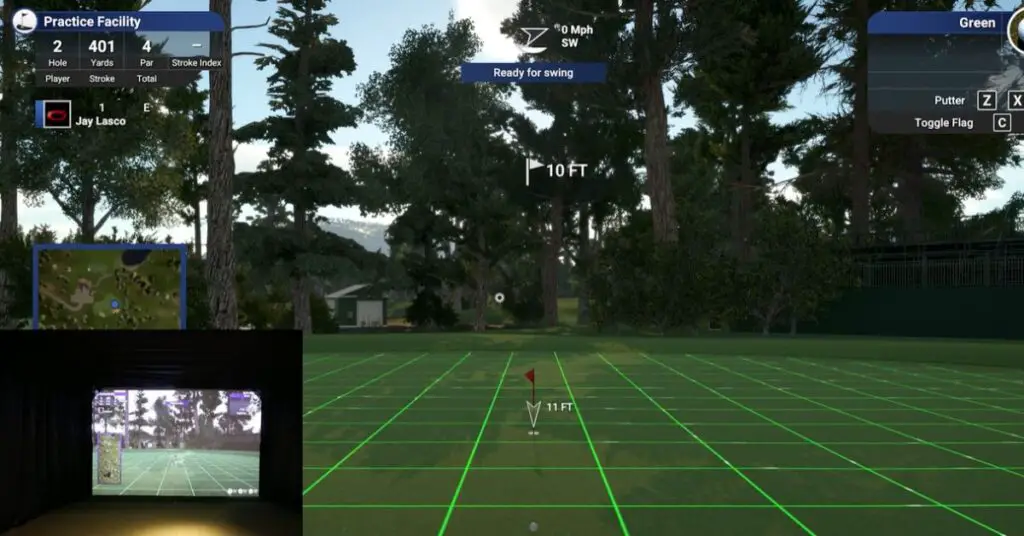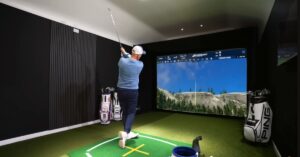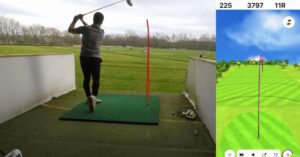How to Putt on a Golf Simulator: Golf Simulator Techniques Explained!
Want to perfect your putting skills in the comfort of your own home? With the help of a golf simulator, you can now practice and improve your short game anytime.
Golf simulators have become increasingly popular, offering a convenient and realistic way to enhance your golfing abilities.
In this guide, we’ll discuss how to putt on a golf simulator, providing expert tips and techniques that will help you lower your scores and become a more confident golfer.
So, grab your putter, and let’s get started on mastering the art of putting on a golf simulator!

Key features to look for in a golf simulator for putting
When looking for a golf simulator specifically for putting, consider the following key features to help you make the most of your indoor practice sessions:
Realistic Green Turf
Choose a simulator with high-quality, realistic artificial turf that closely mimics the feel and response of a real putting green.
This will improve your putting experience and help with consistency in your stroke.
Accurate Ball Tracking
The simulator should provide accurate ball tracking and provide detailed feedback on your putt’s speed, direction, and break.
Systems with high-speed cameras or infrared sensors are ideal for precise tracking.
Adjustable Green Speed
Look for a simulator that allows you to adjust the green speed to replicate various course conditions.
This will help you practice and adapt to different green speeds you may encounter on real courses.
Customizable Slope and Break
Find a simulator that allows you to adjust the slope and break off the putting green. This feature will help you practice reading greens and improve your ability to handle challenging putts.
Variety of Courses and Holes
The simulator should offer a wide selection of courses and hole designs, enabling you to practice various putting scenarios and improve your overall putting skills.
Performance Analytics
The system should provide comprehensive performance analytics, including putt distance, accuracy, and consistency.
This data will help you identify areas for improvement and track your progress over time.
Easy Setup and Portability
Look for a simulator that is easy to set up, break down, and transport, allowing you to practice in various locations or store it when not in use.
Integration with Golf Simulation Software
Ensure the putting simulator is compatible with popular golf simulation software that provides realistic graphics and additional features to enhance your practice experience.
Durability and Quality
Invest in a simulator built with high-quality materials that will withstand regular use and last for an extended period.
Price and Warranty
Consider your budget and look for a simulator that offers the features you need at a reasonable price.
Additionally, check for warranty coverage to ensure you are protected in case of any defects or issues with the system.
Setting Up Your Golf Simulator for Putting Practice
Setting up a golf simulator for putting practice involves several steps. Follow this guide to ensure you have the best possible experience:
Choose a suitable location
Find a flat, level space that is large enough to accommodate your simulator, mat, and any additional equipment. Ideally, the area should be free of obstructions and have adequate lighting.
Make sure there’s enough room for you to swing your putter comfortably without hitting any objects or walls.
Unpack and assemble the equipment
Carefully unpack your golf simulator components, including the mat, sensors, cameras, and any additional accessories.
Follow the manufacturer’s instructions for assembling and installing each part.
Position the mat and sensors
Place the putting mat in the center of the designated area, ensuring it’s flat and stable.
Position the ball tracking sensors or cameras according to the manufacturer’s instructions, so they have an unobstructed view of your putting strokes.
Set up the screen or projector (if applicable)
If your simulator includes a screen or projector, set it up in front of the putting area.
Ensure it’s at a safe distance to prevent any damage from mishit putts. Adjust the screen or projector settings for optimal visibility and image quality.
Connect the electronics
Connect the sensors, cameras, and any other electronic components to your computer, tablet, or other compatible devices.
Ensure all connections are secure and follow the manufacturer’s instructions for any required software installation.
Calibrate the system
Before starting your putting practice, calibrate the simulator according to the manufacturer’s guidelines.
This may involve inputting your putter’s specifications, adjusting sensor positions, or completing a few test putts to ensure accurate tracking.
Adjust the green speed, slope, and break
Customize your practice session by adjusting the green speed, slope, and break settings in the simulator software and experiment with various combinations to replicate different course conditions and challenge your putting skills.
Remember to practice uphill, downhill, and sidehill putts to improve your ability to read greens and handle a variety of situations.
Select a course or practice mode
Choose from the available courses, holes, or practice modes in the simulator software.
Some simulators may offer specific putting challenges or drills, while others may allow you to design custom scenarios to focus on particular aspects of your putting game.
Begin your practice session
Once you have everything set up and calibrated, start your putting practice session.
Take time to focus on your stance, grip, and alignment, ensuring you maintain a consistent stroke throughout your practice.
Use the feedback provided by the simulator to make adjustments and track your progress.
Analyze your performance
Review the data and analytics provided by the simulator after your practice session.
Identify any areas that need improvement, such as distance control, accuracy, or consistency.
Use this information to guide your future practice sessions and focus on specific aspects of your putting game that need attention.
Maintain and store your equipment
Keep your putting mat clean and free from debris, and ensure the sensors and cameras remain properly calibrated.
When you’re not using the simulator, store it in a safe and dry location to protect it from damage.
Putting Drills and Techniques to Practice on a Golf Simulator
Practicing various putting drills and techniques on a golf simulator can help improve your putting skills and confidence on the green. Here are some drills and techniques you can try on your golf simulator:
Straight Putt Drill
Place a ball on a straight, flat line in the simulator, and practice making putts of different lengths (e.g., 3 feet, 6 feet, and 9 feet).
Focus on maintaining a smooth, consistent stroke and aim to make every putt.
Ladder Drill
Set up a series of balls at increasing distances from the hole (e.g., 3 feet, 6 feet, 9 feet, etc.). Make a putt from each distance, aiming to sink each one.
Once you’ve completed the drill, repeat in reverse order, starting with the furthest distance and working your way closer to the hole.
Clock Drill
Place balls around the hole in a clock formation, each at a consistent distance (e.g., 3 feet). Make a putt from each position, focusing on adapting to the different angles and breaks.
Uphill and Downhill Drill
Adjust the simulator to create uphill and downhill slopes. Practice putts of various lengths on both inclines, paying close attention to speed control and the impact of the slope on the break.
Breaking Putt Drill
Set the simulator to create left-to-right and right-to-left breaking putts. Practice reading the break and adjusting your aim and speed accordingly.
Speed Control Drill
Place a target (e.g., a small towel or foam block) approximately 18-24 inches beyond the hole.
Practice putting towards the hole, focusing on speed control. Aim to get the ball to stop as close to the hole as possible without hitting the target.
One-Handed Drills
Practice putting using only your dominant hand or non-dominant hand. This drill can help you focus on the feel and tempo of your putting stroke while improving your control and balance.
Gate Drill
Place two tees, coins, or other small objects about a putter’s width apart on your putting line, creating a “gate.”
Position the ball just behind the gate and practice putting through the gate, ensuring you maintain a straight and consistent stroke.
Pre-shot Routine
Develop and practice a consistent pre-shot routine to improve your mental focus and visualization.
This can include aligning your body, setting your grip, taking practice strokes, and visualizing the putt’s path before executing the stroke.
Pressure Putts
Simulate pressure situations by challenging yourself to make a certain number of consecutive putts from a specific distance or by setting a time limit to complete a drill.
This practice can help you develop the mental resilience needed to handle pressure putts during actual rounds.
Distance Variation
Randomly vary the distance of your putts within a practice session to simulate the unpredictability of real-course putting scenarios.
This will help you adapt to different lengths and improve your overall distance control.
Mirror Drill
Place a small mirror on the ground and position the ball on top of it. Practice your putting stroke while keeping your head steady and watching your eyes in the mirror. This drill helps improve your head position and stability throughout the stroke.
Additional Tips for Improving Your Putting on a Golf Simulator
Improving your putting skills on a golf simulator can be a bit different than practicing on a real green.
However, by following these tips, you can make the most out of your golf simulator experience and improve your putting:
Choose a high-quality simulator
Ensure that you’re using a golf simulator with accurate ball tracking technology and realistic green contours.
This will help you get more accurate feedback on your putting stroke and better replicate real-life conditions.
Consistency in setup
Focus on maintaining a consistent setup with every putt. This includes proper alignment of your body, clubface, and ball position.
Make sure to keep your eyes on the ball and maintain a stable base to ensure a smooth stroke.
Practice different putts
Golf simulators provide a variety of settings and options, allowing you to practice different types of putts, including uphill, downhill, and breaking putts.
Use this versatility to practice a wide range of putting scenarios to improve your overall putting ability.
Focus on tempo
Develop a consistent tempo for your putting stroke. A smooth, even pace will lead to more consistent results. Use a metronome or other timing device to help establish a rhythm that works for you.
Work on distance control
Use the golf simulator to practice lag putting and dial in your distance control. Start by aiming for a specific distance and then gradually increase the target distance as you become more confident.
Analyze your stroke
Many golf simulators provide detailed feedback on your putting stroke, such as face angle, swing path, and impact point. Use this data to identify any inconsistencies and make adjustments to improve your technique.
Set goals
Set specific, measurable goals for your putting practice sessions, such as making a certain number of putts from a particular distance or improving your overall putting average. This will help keep you motivated and focused on your progress.
Be patient
Improving your putting takes time and practice. Don’t get discouraged if you don’t see immediate results. Stick with your practice routine and continue working on your technique; you’ll see improvement over time.
Incorporate drills
Use various putting drills to hone specific aspects of your putting game, such as alignment, distance control, and tempo. Some popular drills include the ladder, clock, and gate.
Combine simulator practice with real-life practice
Although golf simulators provide valuable feedback and practice opportunities, nothing can fully replicate the experience of putting on a real green.
Make sure to balance your simulator practice with real-world putting practice to ensure the well-rounded development of your putting skills.
Can golf simulators accurately replicate putting conditions?
While golf simulators cannot perfectly replicate real-life putting conditions, they have come a long way in providing a realistic experience.
High-quality simulators use advanced technology to simulate green contours, speed, and ball tracking, allowing golfers to practice and improve their putting skills effectively.
FAQs
How can I practice my putting on a golf simulator?
To practice putting on a golf simulator, choose a high-quality simulator with accurate ball tracking and realistic green conditions.
Set up consistent practice sessions, working on various types of putts, focusing on tempo, distance control, and stroke analysis.
Incorporate putting drills and set goals to keep your practice engaging and productive.
Are there specific putting drills I can use on a golf simulator?
Yes, several putting drills can be used on a golf simulator. Some popular drills include the ladder drill (for distance control), the clock drill (for consistency and accuracy), and the gate drill (for improving clubface alignment and swing path).
Can I improve my real-life putting skills using a golf simulator?
Absolutely! Golf simulators can provide valuable feedback and practice opportunities that can help improve your putting skills.
However, balancing your simulator practice with real-world putting practice is essential to ensure a well-rounded development of your skills.
How do I analyze my putting stroke on a golf simulator?
Many golf simulators provide detailed feedback on your putting stroke, such as face angle, swing path, and impact point. Use this data to identify inconsistencies and make adjustments to your technique.
Some simulators also offer visual aids, such as 3D renderings of your stroke or instant replays, to help you analyze your performance.
How often should I practice putting on a golf simulator?
The frequency of practice depends on your goals and schedule. In general, practicing your putting on a golf simulator consistently, such as a few times a week, will lead to improvement over time.
Remember to balance simulator practice with real-life putting practice for the best results.
Can I use my own putter on a golf simulator?
Yes, most golf simulators allow you to use your own clubs, including your putter. Using your own putter during simulator practice can help maintain consistency and familiarity, leading to better results when transitioning to real-life putting.
Is putting on a golf simulator suitable for beginners?
Golf simulators can be an excellent tool for beginners to learn and practice putting. The immediate feedback and ability to practice various types of putts in a controlled environment can help accelerate skill development and build confidence.



![How Does Putting Work On Golf Simulator? [Ultimate Guide] How-Does-Putting-Work-On-Golf-Simulator](https://giftedgolfers.com/wp-content/uploads/2023/01/How-Does-Putting-Work-On-Golf-Simulator-300x157.jpg)

![Can A Golf Simulator Improve Your Game? [From Zero to Hero] Can-A-Golf-Simulator-Improve-Your-Game](https://giftedgolfers.com/wp-content/uploads/2023/01/Can-A-Golf-Simulator-Improve-Your-Game-300x157.jpg)
